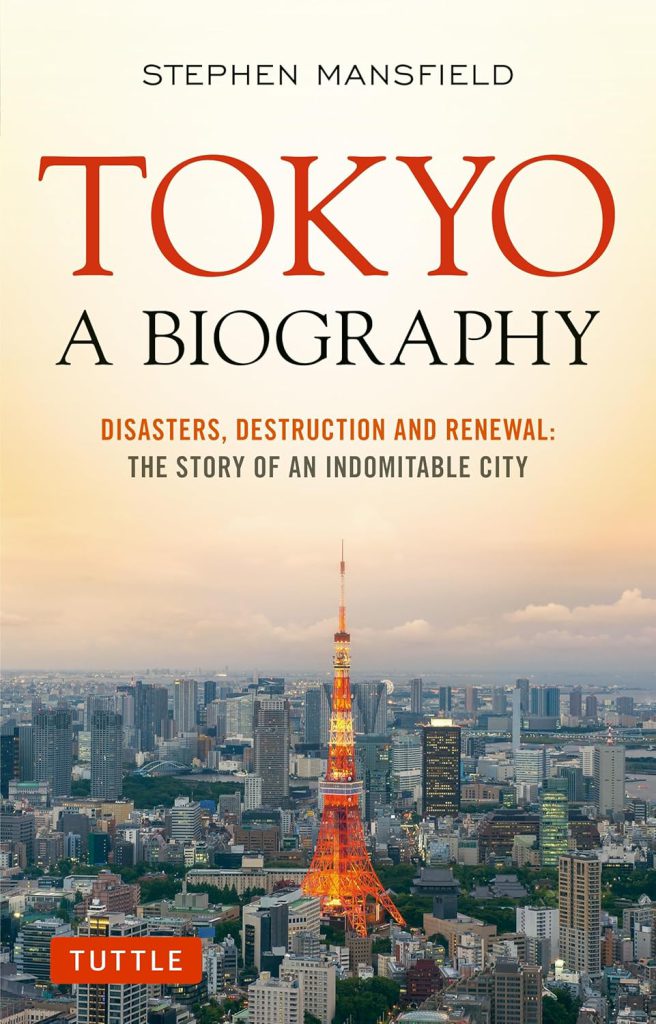
Book Review of Tokyo: A Biography by Stephen Mansfield (208 pages) Disasters, Destruction and Renewal: The Story of an Indomitable City
Tokyo, the city, the metropolis, the legend, has always been overpowering to me. It has intimidated and frightened me by its vastness. This fear morphed into disdain and a belief that in some ways Tokyo was economically elitist, a sort of silver spooned child built on the hard work of the rest of the country. To be honest, these feelings lingered so much so that I have made it a hobby to on far too many occasions to announce: “Tokyo, that’s not the real Japan”.
For some reason these feelings have never been assuaged by the Osakans living around me.
So, how does someone give Tokyo a new look and a fair shake? How does someone take in something so enormous in size and scope? How does someone get a real grasp on this monster that is at the same time one city while also being its own country as well as multiple worlds. How does one encapsulate all that in 200 pages?
Well, the answer to all of the above is that you need a guide, and the better the guide the better all of those fears subside and the questions are answered.
Our guide in Tokyo: A Biography is the fantastic Stephen Mansfield. Mansfield is a journalist and photographer with decades of experience covering Asia for numerous publications (such as the Japan Times, Japan Quarterly, and Newsweek) and numerous books covering the areas of Laos, stone gardens, Japan, and more specifically, Tokyo.
Within the pages of Tokyo: A Biography, like the biography of any great boxing champion, Mansfield begins to make Tokyo accessible by illuminating its humble beginnings along with the innumerable setbacks throughout its growth. Describing the initial group of ronin and single men coming to Edo in the early development of Tokyo as a hub, Mansfield says of their living quarters,
Communal facilities included garbage dumps, the toilet and the well… rats were drawn to the garbage piles… sleeping conditions inside the row houses must have been suffocating… (and) in a normal year the Sumida River could be expected to flood twice, its inundations turning districts along its banks into quagmires of foul-smelling mud.
This certainly gives context to the sacrifices made of the initial inhabitants to build the great city today, and Mansfield’s accessible and straightforward writing style paints a picture of the hard work and dedication needed to build up Tokyo.
Continuing to guide us through time, Mansfield shows how our hard punching Edo grows into Tokyo and again, just when our champion appears to be unbeatable, how it comes up against three insurmountable opponents – Fire, Earthquake, War.
Though little of the basic history will come as a surprise, the advantage of having a brilliant guide shows itself again with Mansfield’s descriptions of these disasters. Speaking of those caught between two walls of fire after the devastating 1923 quake, Mansfield writes:
Tokyo was burning on both sides of the river… a strange phenomenon was taking place as fires in the Nihonbashi commercial district merged, then leapt across the river… those not lifted up by the spirals of flame and then dropped to the ground in molten balls of fire were caught under showers of sparks that set their belongings ablaze. Some 44,000 people perished at the depot. The bodies, reduced to ashes, were placed in crude receptacles made from corrugated iron.
Only a true champion could take such punches and rise again, and again, and again. Mansfield gives us the story of a Tokyo with just enough sympathy to make anyone appreciate the tenacity of what it took to survive, let alone succeed.
However, Mansfield never refuses to confront some of the darker sides of Tokyo. The Koreans unjustly attacked as scapegoats and slaughtered in the midst of that same 1923 disaster are addressed and the shame of such human evil is never shied away from. Mansfield refuses to give us a polished and cleaned version of the history of Tokyo. While our guide certainly loves the capital, even such dark parts are examined without blinders.
Overall, this is a short examination that takes on a huge task. Anyone looking for more detailed research on any particular event will need to continue reading after this book. However, this is a wonderful short read for anyone without the time or inclination to go into more detail, and it may work (as it did for me) as a catalyst towards subjects that pique your interests.
In the end, maybe I was wrong about Tokyo, and maybe I need to change my attitude. Nevertheless, my reaction seems common, and at one point Mansfield himself addresses these feelings:
“Edokko” meaning “true child of Edo” prided themselves on being unproductive and expressed open contempt for pecuniary concerns… they were not universally liked. The diligent tradesmen of Osaka, for example, derided the Edokko as “rakes and profligates of Edo, hot-blooded but hairy-brained, putting assets into bottomless bags”.
So, maybe I will begin to respect Tokyo a bit more, but most likely I’ll justify my position as one backed historically and just start calling the businessmen of new Edo “hairy-brained”. One more nugget gained from the tremendous writing and guidance of Stephen Mansfield.
A worthy read from an interesting and well-informed author.
********************
For an account of Stephen Mansfield’s 2019 presentation to WiK, see here. For his review of the WiK Anthology 3, Encounters with Kyoto, please click here. For his amazon page with a list of his books, please see this link.
